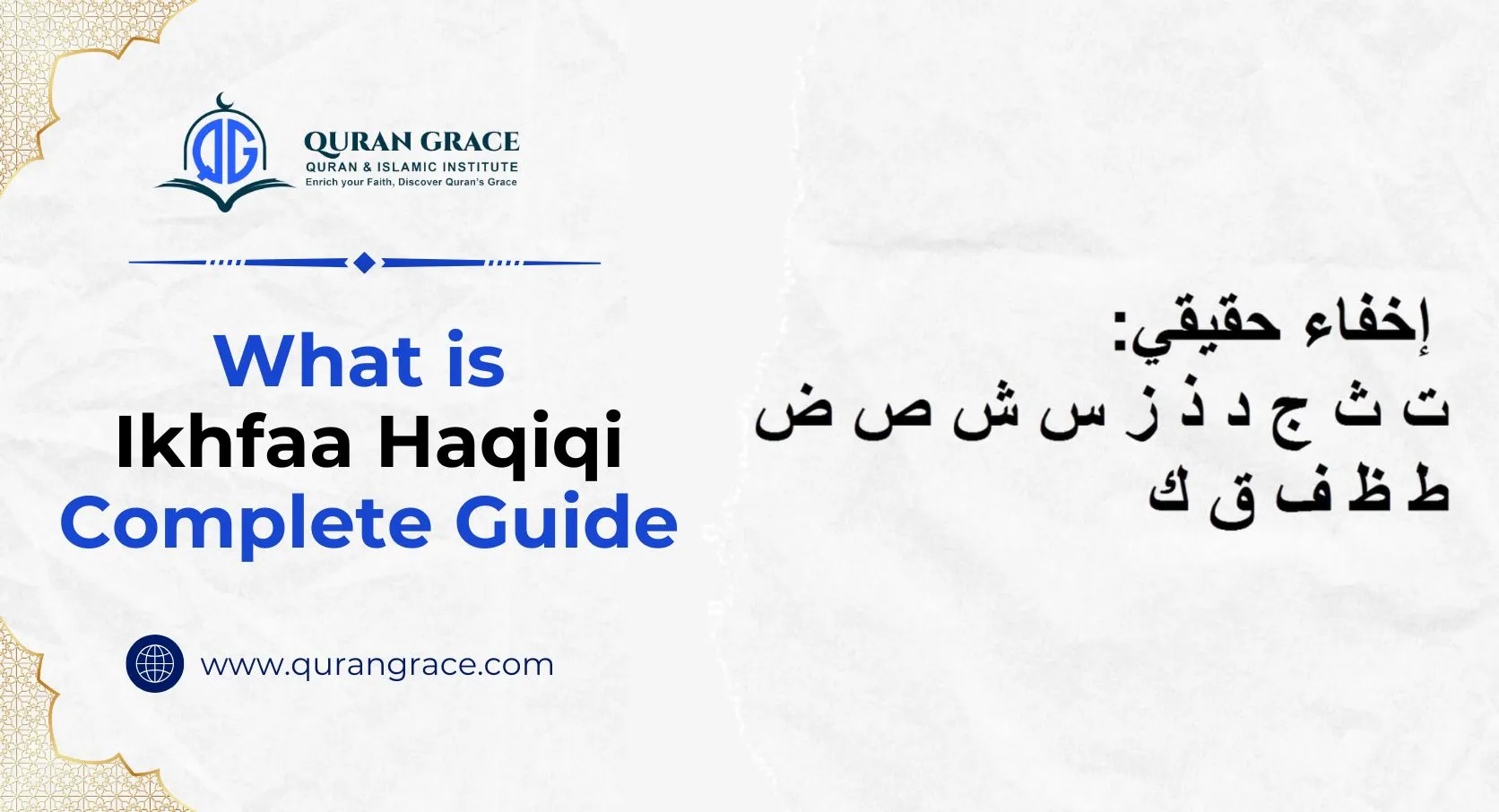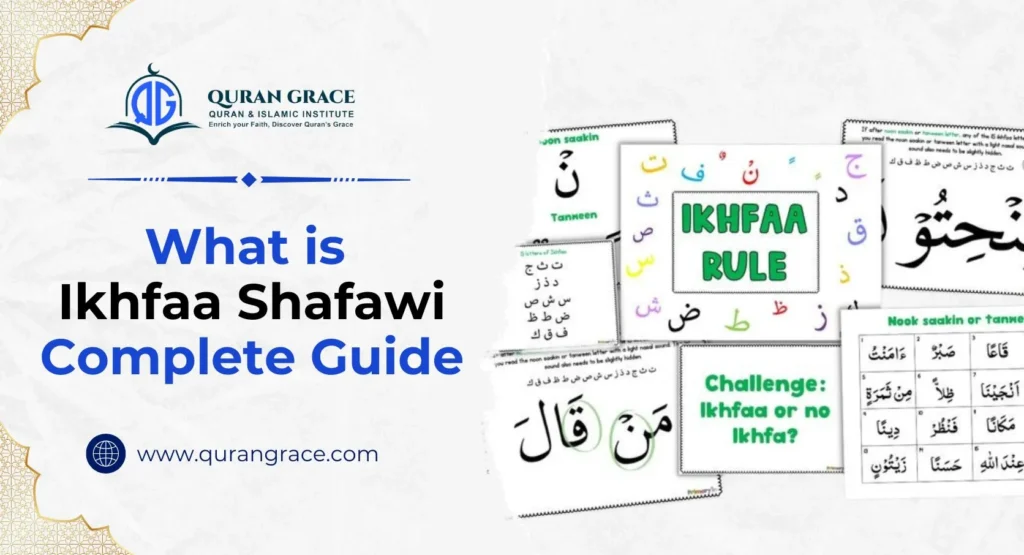Reciting the Quran with proper Tajweed is an essential practice that significantly enhances the accuracy of pronunciation, ensuring the integrity and beauty of the words of Allah are maintained. Among the various rules of Tajweed, Ikhfaa Haqiqi stands out as one of the most fundamental and is crucial for effective recitation. Mastering this particular rule not only enriches the reciter’s experience but also upholds the sacredness of the text, making it an integral part of any advanced Tajweed course.
Meaning of Ikhfaa Haqiqi
The term “Ikhfaa” (الإخفاء) in Arabic translates to “to hide” or “to conceal.” In the realm of Tajweed, which is the art of reciting the Quran, Ikhfaa refers to the technique of partially concealing the sound of a letter during pronunciation.
A specific aspect of this practice is known as “Ikhfaa Haqiqi” (الإخفاء الحقيقي), or “true” or “real” concealment. This principle is particularly relevant when dealing with the letter Noon Sakinah (نْ) and Tanween (ًٌٍ), where certain rules dictate the appropriate way to achieve this concealment in recitation.
The Ikhfaa Haqiqi Rule
The rule of Ikhfaa Haqiqi is an important aspect of Tajweed, which governs the proper pronunciation of letters in the recitation of the Quran. It represents a state of pronunciation that exists between two other key Tajweed rules:
- Izhar (الإظهار): This rule refers to the clear and distinct pronunciation of a letter.
- Idgham (الإدغام): This involves the complete merging of one letter into the next.
Ikhfaa Haqiqi is characterized by a gentle and flowing transition in which the sound of the Noon Sakinah (نْ) or Tanween (ًٌٍ) is neither fully pronounced nor entirely merged. Instead, the sound is “hidden” with a nasal resonance, known as ghunnah (غُنَّة).
According to this rule, when a Noon Sakinah or a Tanween is immediately followed by one of the 15 Ikhfaa letters, the sound of the Noon or Tanween is concealed, and a ghunnah is produced for a duration of two counts. This technique enhances the melodic quality of recitation while maintaining clarity in pronunciation.
The 15 Letters of Ikhfaa Haqiqi
Ikhfaa Haqiqi is applied when Noon Sakinah or Tanween is followed by any of these 15 letters. A common way to memorize them is by remembering the first letter of each word in the following poetic phrase:
صِفْ ذَا ثَنَا كَمْ جَادَ شَخْصٌ قَدْ سَمَا # دُمْ طَيِّبًا زِدْ فِي تُقًى ضَعْ ظَالِمَا
The letters are:
- ت (Taa)
- ث (Thaa)
- ج (Jeem)
- د (Daal)
- ذ (Thaal)
- ز (Zay)
- س (Seen)
- ش (Sheen)
- ص (Saad)
- ض (Daad)
- ط (Taa)
- ظ (Thaa)
- ف (Faa)
- ق (Qaaf)
- ك (Kaaf)
Examples of Ikhfaa Haqiqi
- Noon Sakinah with Ikhfaa:
- مَنْ جَاءَ (man-jaa’): The Noon Sakinah is followed by Jeem (ج). You hide the ‘n’ sound and produce a light ghunnah.
- مِنْ قَبْلُ (min-qabl): The Noon Sakinah is followed by Qaaf (ق). The ghunnah here will be heavy.
- Tanween with Ikhfaa:
- شَيْءٍ قَدِيرٌ (shay’in qadeer): The Tanween is followed by Qaaf (ق). The ghunnah will be heavy.
- مَاءً ثَجَّاجًا (maa’an thajjaajan): The Tanween is followed by Thaa (ث). The ghunnah will be light.
Ikhfaa Haqiqi vs. Ikhfaa Shafawi
It’s important not to confuse Ikhfaa Haqiqi with Ikhfaa Shafawi (oral concealment).
- Ikhfaa Haqiqi: Applies to Noon Sakinah (نْ) and Tanween (ًٌٍ) when followed by one of the 15 Ikhfaa letters.
- Ikhfaa Shafawi: Applies only to Meem Sakinah (مْ) when it is followed by the letter Baa (ب). This rule is called “Shafawi” because both letters are articulated from the lips (shafah).
How to Pronounce Ikhfaa Haqiqi
The correct pronunciation of Ikhfaa Haqiqi requires a specific technique:
- Understanding the Ghunnah:
The ghunnah is a crucial aspect of pronunciation in Arabic, characterized by a distinct nasal sound that is sustained for approximately two counts.
- Tongue Positioning:
When articulating the letter Noon (ن), it is important to position your tongue correctly. The tongue should avoid contact with the upper palate or gums. Instead, it should rest in a state of readiness, prepared to pronounce the following Ikhfaa letter. This slight separation from the upper gums is essential for producing the “hidden” or “concealed” sound associated with the Noon.
- Visual Cues in Uthmani Script:
In the Uthmani script of the Quran, a notable feature is the absence of a shaddah (a small ‘w’ shape indicating a doubled letter) on the letter that follows Noon Sakinah or Tanween. This absence signifies that Noon is not completely integrated into the subsequent letter, highlighting the unique qualities of its pronunciation.
Levels of Ikhfaa
The strength or level of Ikhfaa varies depending on how close the articulation point of the Ikhfaa letter is to the articulation point of Noon (ن).
- Highest Level: This occurs with the letters ت, د, and ط. Their articulation points are very close to those of Noon, making the concealment almost like a light Idgham.
- Lowest Level: This happens with the letters ق and ك. Their articulation points are the farthest from Noon, making the concealment more subtle and closer to Izhar.
- Intermediate Level: This applies to the remaining ten letters, where the Ikhfaa is in a balanced state.
Heavy and Light Ghunnah
The quality of the ghunnah in Ikhfaa Haqiqi is also influenced by the following letter.
- Heavy Ghunnah (Tafkheem): If the Ikhfaa letter is one of the “heavy” letters (ص, ض, ط, ظ, ق), the ghunnah will also be heavy and full-mouthed. Your mouth should take on a fuller shape in preparation for the sound.
- Light Ghunnah (Tarqeeq): If the Ikhfaa letter is one of the “light” letters, the ghunnah will be light and thin.
Conclusion
Mastering Ikhfaa Haqiqi is an essential aspect of enhancing your Quranic recitation. This technique involves understanding its definition, identifying the specific letters associated with it, and practicing correct pronunciation. You can join our online Quran tajweed course to learn all the Tajweed rules with perfection.








